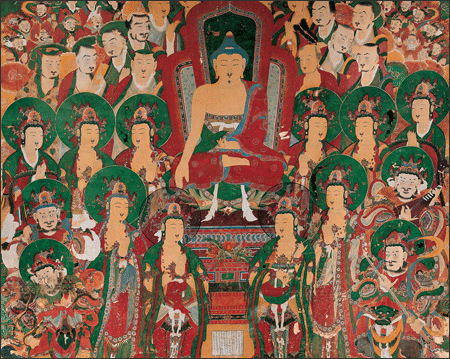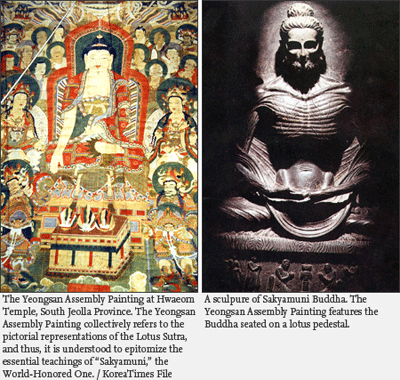
On Vulture Peak, an endless multitude of crowds gathered to listen to Sakyamuni Buddha preaching “the scripture of the Lotus of the Wonderful law” – the Lotus Sutra.
The vast assembly of listeners included bodhisattvas, arhats, monks, nuns, laymen, laywomen, heavenly beings and spirits.
A rain of various heavenly flowers landed upon this great assembly while Buddha emitted a ray of light from the tufts of white hair between his eyebrows, extending down to the lowest hell and up to the highest heavens, lighting up 18,000 worlds.
All those at the assembly were filled with joy and gazed at the Buddha with a single mind.
In essence, this scene is embodied in the Yeongsan Assembly Painting. The locale Yeongsan, a shortened appellation for “Yeongchwisan,” is a Korean transcription of Mount Gridhrakuta, or Vulture Peak, situated on the outskirts of Rajagrha (modern Rajgri), northern India.
The site holds historical significance as one of the most notable places where Sakyamuni propounded his doctrine during his lifetime.
In the tradition of Korean Buddhist paintings, the Yeongsan Assembly Painting collectively refers to the pictorial representations of the Lotus Sutra, and thus, it is understood to epitomize the essential teachings of Sakyamuni, the World-Honored One.
The opening chapter of the Lotus Sutra enumerates those who participated in the assembly and describes the miraculous events that occurred prior to the deliverance of the lecture by the Buddha upon the request of Sariputra (“Saribul” in Korean), one of his two principle disciples.
The most quintessential representations take this narrative delineated in the introduction and effectively illustrates the scene in a single picture plane.
In the painting, the principle figure, the Sakyamuni Buddha, is seated on a lotus pedestal and his hands are either in a teaching “mudra” (hand gesture) or in an earth-touching mudra (enlightenment) position.
Centering the Buddha, the entourage of listeners is hierarchically positioned. The combinations of bodhisattvas, ten disciples, eight kinds of beings, four guardian gods, as well as numerous Buddhas of the past and future suggestively encompass the staggering crowd at the assembly.
Sometimes the details such as the ray of light emanating from the Buddha and the heavenly musicians playing various instruments are incorporated to amplify visual interest.
The degree of elaboration, the number of attendants, or the arrangements can vary from one painting to the next, but they generally follow a basic scheme.
Among the paintings that are known today in Korea, the Yeongsan Assembly Painting (1729) from Haein Temple in North Gyeongsang Province is celebrated for its exquisite quality.
The streaks of golden light protrude from the centrally positioned Buddha, and on the top register is a depiction of numerous Buddhas, some on floating clouds.
The individuals of the Buddhist pantheon are arranged in an orderly fashion. Moreover, the decreasing size of the figures, from the bottom to the top, creates an illusion of unlimited extension of space.
Together with the scene of the assembly, the painting may include additional narratives from specific chapters of the Lotus Sutra. As best exemplified in the Yeongsan Assembly Painting (1725) from Songgwang Temple in South Jeolla Province, Sariputra appears at the lower register facing the Buddha.
The painting vividly stages the scene of Sariputra begging the Buddha to preach. In other paintings, the rising stupa or the white-robed “Gwaneum” (the Bodhisattva Perceiver of the World’s Sounds) is added.
These additional features present intriguing variations, but they only sporadically appear during the course of the Joseon Kingdom (1392-1910).

In the tradition of Mahayana Buddhism, the Lotus Sutra is one of the most revered sacred scriptures. Among several translated texts, the Chinese translation of Kumarajiva, a central Asian monk, in 406 was most widely used in East Asia.
In Korea, the faith associated with the Lotus Sutra is conjectured to have already existed from the sixth century, and since its transmission, the Lotus-inspired thought has exercised its influence on many facets of Korean Buddhism.
With its popularity, the Lotus Sutra naturally has been a favored subject for visual representations.
Especially the illustrated sutras from the Goryeo Kingdom (918-1392) display exceptional artistry.
And it is those illustrations of the assembly, evident as early as the eleventh century that became the iconographical basis for the Yeongsan Assembly Paintings in Joseon.
By the late Joseon Kingdom, the Yeongsan Assembly Painting constituted the majority of Buddhist paintings and these days visitors can come across one in almost all Buddhist temples in Korea.
The Yeongsan Assembly Painting usually serves as the main altarpiece placed behind the seated Buddha statue/statues in the Great Shrine Hall, or Yeongsan Hall. As with other paintings, it functions to adorn the religious premises, yet more importantly the painting itself becomes an object of veneration.
The visual reenactment presented in the painting of the assembly transcends our concepts of time, space, and possibility. The Yeongsan Assembly Painting hence truly involves the attendants limitlessly.
When you stand before the painting, the event has already included you over time and space and you are present in the all time lecture on “the law that is profound and never known before” directly delivered by the World-Honored One.
Author : Taylor Pak
Source : http://www.koreatimes.co.kr




